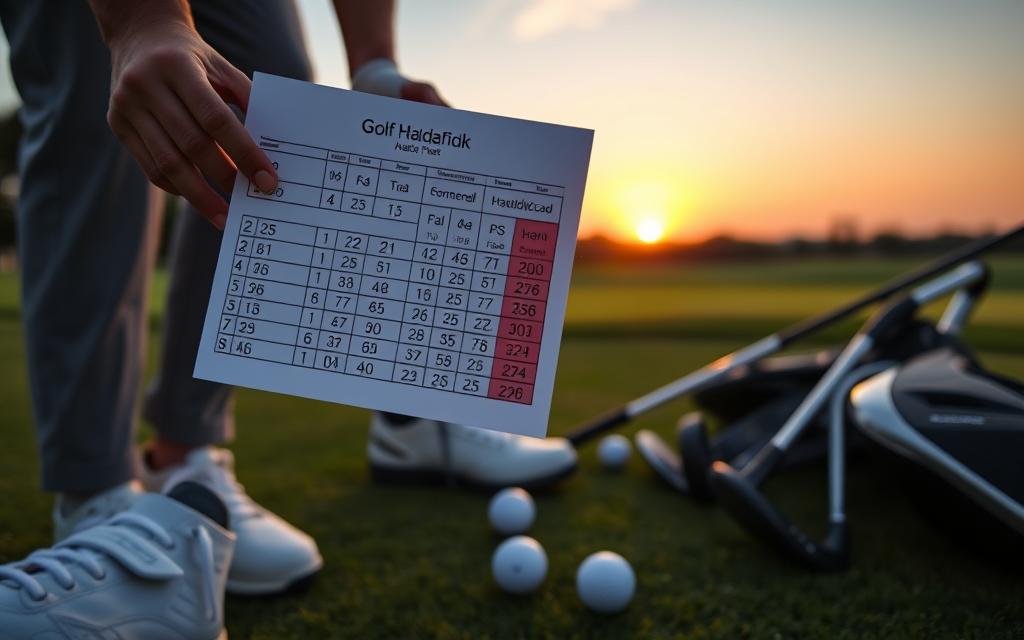Ever wondered how golf handicaps affect match play? Knowing how to calculate and use them is key for fair play. This guide will cover the basics of golf handicaps and strategies for match play.
Golf handicaps are more than just your skill level. They’re vital in match play. Find out how to use them to your advantage in this article. Learn about golf handicap calculation and match play rules to improve your game.
Key Takeaways
- Golf handicaps are essential for creating a fair and competitive environment in match play.
- Proper understanding of handicap calculation and application can give you a strategic edge in head-to-head competitions.
- Familiarize yourself with the factors that influence course handicaps, such as course rating and slope.
- Learn to effectively apply handicap strokes in various match play formats, including head-to-head and four-ball matches.
- Utilize available resources and tools to stay up-to-date on the latest handicap guidelines and regulations.
Understanding the Basics of Golf Handicaps
In golf, handicaps are key to fair play. They show a player’s skill level. This way, players of all levels can play together, making golf fun for everyone.
What is a Golf Handicap?
A golf handicap shows a player’s skill. It’s based on their past scores. The lower the number, the better the player.
Why Handicaps Are Important
Handicaps make golf fair and fun for all. They let players of different skills compete. They also help players see how they’re doing and where they can get better.
Types of Golf Handicaps
There are two main types: gross score and net score. Gross score is the total strokes taken. Net score is gross score minus handicap. The golf handicap index shows a player’s skill level.
| Handicap Type | Description |
|---|---|
| Gross Score | The total number of strokes a player takes on a round, without any adjustments. |
| Net Score | The player’s gross score minus their handicap, reflecting their adjusted score for the round. |
| Handicap Index | The primary measure of a player’s skill level, used to calculate their course handicap. |
Knowing about golf handicaps is key for fair play. It’s important for net score vs gross score and other game formats.
The Role of Handicaps in Match Play
In golf, knowing how handicaps and match play work together is key. Handicaps make sure everyone has a fair chance, no matter their skill level.
How Handicaps Affect the Game
Handicaps in match play make the game fair by giving handicap strokes to the better player. These strokes are given on the toughest holes. This way, both players have a good shot at winning.
Comparison to Stroke Play
But, in stroke play, handicaps work differently. Here, players’ net scores are found by subtracting their handicaps from their total scores. This means players have to manage their handicaps all game, not just on certain holes.
| Match Play | Stroke Play |
|---|---|
| Handicaps directly applied through stroke allocation | Net scores calculated by subtracting handicaps from gross scores |
| Focuses on head-to-head competition | Emphasizes overall performance throughout the round |
| Handicaps influence hole-by-hole outcomes | Handicaps affect the final score, not individual hole results |
Knowing how handicaps work in match play helps golfers plan better. They can use this knowledge to improve their chances of winning in these competitive games.

Calculating Your Golf Handicap
Learning how to figure out your golf handicap is key to enjoying the game. It’s very important when you play matches. You need to follow a few steps to get a fair score that shows how good you are at golf.
Steps to Calculate Your Handicap Index
- Keep track of your last 20 golf scores.
- Use the equitable stroke control (ESC) method to fix any very high scores. This makes your score more real.
- Find the differential for each round. Do this by subtracting the course rating from your score, then divide by the slope rating.
- Pick the lowest 8 differentials from your last 20 rounds.
- Add up these 8 lowest differentials and divide by 8. This gives you your handicap index.
Using Scorecards for Accurate Calculation
It’s very important to keep detailed scorecards. This helps you figure out your handicap calculation accurately. Make sure to write down:
- Course name and location
- Date of play
- Gross score (total strokes taken)
- Course rating and slope rating
By keeping good records, your handicap index will show your true golf skills. This makes sure you play fairly in equitable stroke control during matches.
| Round | Gross Score | Course Rating | Slope Rating | Differential |
|---|---|---|---|---|
| 1 | 85 | 72.5 | 130 | 10.2 |
| 2 | 92 | 73.0 | 135 | 14.1 |
| 3 | 88 | 71.5 | 128 | 12.9 |
| 4 | 79 | 70.0 | 125 | 7.0 |
| 5 | 83 | 72.0 | 132 | 8.3 |
How to Determine Your Course Handicap
Understanding your course handicap is key to enjoying golf. It’s a personal measure that considers your golf handicap index and the course’s features.
Factors Influencing Course Handicap
Several things affect your course handicap:
- Your golf handicap index shows your skill level based on past scores.
- The course rating shows how hard the course is for a scratch golfer.
- The slope rating shows how hard the course is for golfers of different skills.
Understanding Course Rating and Slope
The course rating and slope rating are important for your course handicap. The course rating is the score a scratch golfer would get. The slope rating shows how hard the course is for different skill levels.
Knowing your course handicap can change the game in match play. It lets you plan and compete fairly, no matter the course.
Applying Handicaps in Match Play Scenarios
In the exciting world of match play, knowing how to use golf handicaps is key. It makes sure everyone has a fair and fun time. Handicap allowances and how they work are important to grasp.
The Concept of Allowances
In match play, handicaps work in a special way called “allowances.” Players get a number of strokes based on their handicaps. These strokes are used on certain holes during the game. This makes the game fair and fun for everyone.
Examples of Handicap Application
Let’s look at a few examples of how handicaps are used in match play:
- Head-to-Head Match: Player A has a handicap of 12, and Player B has a handicap of 8. Player A gets 4 strokes for the toughest holes.
- Four-Ball Match: Team A’s total handicap is 18, and Team B’s is 22. Team B gets 4 strokes for the hardest holes.
| Scenario | Handicap Allowance |
|---|---|
| Head-to-Head Match | Player A (12) receives 4 strokes from Player B (8) |
| Four-Ball Match | Team B (22) receives 4 strokes from Team A (18) |
Understanding handicap allowances helps you plan better. It lets you adjust your game for a fair and fun golf experience.
Common Match Play Formats
Golf has a special format called match play. It’s different from stroke play. Knowing the match play formats and how handicaps work can help you play better. Let’s look at two main formats: head-to-head matches and four-ball matches.
Head-to-Head Matches
In head-to-head matches, two players face off. The player with the lower handicap strokes gets a stroke advantage. It’s a one-on-one battle where each player’s skills matter a lot. Winning means using your opponent’s weaknesses and playing smart.
Four-Ball Matches
Four-ball matches are team play. Two players on each team play together. The team with the better score on each hole wins. Handicaps are key here, as each player gets their full handicap. Teamwork and strategy are vital in four-ball matches.
| Match Play Format | Handicap Application | Key Strategies |
|---|---|---|
| Head-to-Head | Difference in handicap strokes between players | Capitalize on opponent’s weaknesses, minimize errors |
| Four-Ball | Full handicap for each player, better ball scoring | Effective team communication and strategy |
Knowing the match play rules and how handicap strokes work can improve your game. It helps you make smart choices and plan your next match play competition.

Tips for Using Handicaps Effectively in Match Play
As a golfer, knowing how to use your handicap can really help in match play. It’s key to understand how to adjust your handicap for a fair game. Here are some tips to help you use your handicap well in match play.
Strategy Considerations
In match play, think strategically. Here are some tips to help you use your handicap wisely:
- Get to know the course layout and conditions. This helps you plan your game better.
- Focus on your own game, not your opponent’s. Aim to play your best, not to beat them.
- Know when to use your handicap. This can really change the game’s outcome.
Consistency and Practice
Playing consistently is key for a good handicap. Regular practice helps you improve and keeps your handicap accurate.
- Play a set number of rounds to keep your handicap current.
- Keep working on your skills to get better.
- Check and adjust your handicap regularly to match your current level.
By following these tips, you can use your handicap to your advantage in match play. Success comes from understanding handicaps and using them to improve your game.
Resources for Golf Handicaps and Match Play
Exploring golf handicaps and match play can be exciting. It’s important to have good resources. This section will show you where to find them. You’ll learn about official golf sites, online tools, and apps to help you improve.
Official Golf Organizations
The United States Golf Association (USGA) and the Royal and Ancient Golf Club of St Andrews (R&A) set golf rules. They handle handicaps too. Their websites and publications are full of useful info for better golf.
Online Tools and Apps for Handicaps
Today, there are many online tools and apps for golf handicaps. The USGA’s Golf Handicap Information Network (GHIN) is one. These tools make tracking your handicap easy. They save you time and help you do well in matches.


